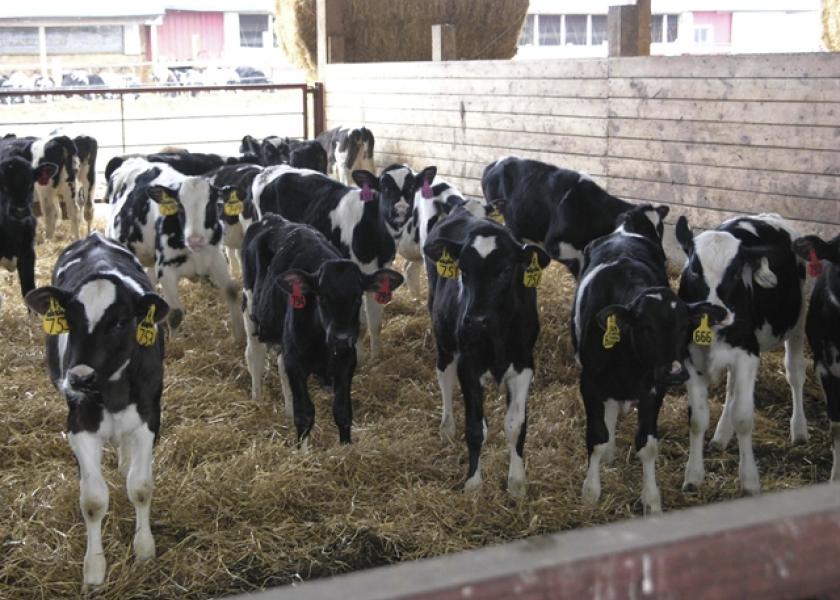Minimizing Respiratory Disease in Young Dairy Calves in Calf Barns

Respiratory disease is the second leading cause of death in un-weaned heifer calves (scours is the first).
By: Tracey Erickson, SDSU Extension Dairy Field Specialist
Unfortunately, heifers that experience respiratory disease also continue to perform poorly later in life. To effectively address these problem producers must consider both determinant and predisposing causes of respiratory disease.
Predisposing Causes
First what is the level of passive immunity being transferred unto the calf? Current guidelines suggest baby calves should receive high quality colostrum right after birth, 3-4 quarts within one hour and 3 additional quarts within twelve hours.
Quality of colostrum is important. Collecting colostrum under strict sanitary conditions is also vital to help minimize bacterial growth. Some producers pool colostrum to increase protection from a wider range of pathogens the calf might be exposed to. However, when doing this, one also needs to make sure not to use colostrum from first calf heifers or Johne’s infected cows. Secondly, adequate storage of colostrum is important to minimize bacterial growth. Colostrum should be refrigerated or frozen as soon as possible after collection.
Checking serum protein levels in calves aged 1-7 days will help assess the farm’s colostrum feeding program. Serum protein in these calves should be greater than 5.5 mg/dl, with borderline levels between 5.0 and 5.4 mg/dl as a group average.
Research has shown colostrum pasteurization does not interfere with immunoglobulin’s (IgG) availability and that it decreases total bacteria counts (Johnson et al. 2007). However, pasteurization should be done by heating the colostrum to 140 ° F (60°C) for 60-120 minutes in a batch pasteurizer. These pasteurizers use lower temperatures and longer heating times which do not damage milk immunoglobulins. Unfortunately, these types of pasteurizers can be quite expensive with some producers using them also to pasteurize their waste milk in order to spread out this expense.
Cleanliness is very important to help minimize risks; a clean and dry calf living environment is critical. Calves should not have shared housing with cows during the first week of their lives and should be removed from maternity pens as soon as possible. Cleanliness of the calving pen is also important because it will reduce bacterial load and exposure to possible pathogenic diseases.
Raising calves in barns is convenient as it provides protection from the weather for both calves and employees. However, there are environmental risk factors that need to be addressed. The following should be used as a guide to reduce respiratory disease when using calf barns.
- Feed adequate amounts of colostrum, (see above).
- Avoid nose-to-nose contact between calves (solid separation panels if possible if individual pens are utilized) in the early days of life before they are co-mingled in group pens.
- Reduce microbial contamination in the pen via adequate sanitation; increase pen area (ideal: 30-35 square feet per calf)
- Use cold-temperature housing
- Use smaller group pen sizes to enable better monitoring and growth rates in early stages of pre-weaned calf groups.
- In pen raising where automatic feeders are utilized, sanitation, dry bedding and all in all out groups cleaning practices need to be followed. Detail in these areas is critical for success.
- Increase bedding depth in colder weather.
- Use calf blankets in cold temperatures, even in cold barn housing
- Provide adequate ventilation with an air exchange rate of 4 exchanges in winter months and 40 exchanges in hot summer days.
- Provide additional nutrients via calf starter or milk in cold-temperature housing.
- Allowing extra time to be spent observing calves and record keeping is critical.
Determinant Causes
If calves have received adequate immunity via colostrum, the next step is to reduce the microbial challenge. This means removing the calf from the dam as soon as possible. Calves should then be placed in individual pens avoiding nose-to-nose contact with other calves.
Vaccines are now being marketed for prevention of clinical respiratory diseases. Traditional views have held that the antibodies calves receive through colostrum usually inactivate the vaccines administered to them. More recent research indicates that, in certain instances, modified live viral (MLV) vaccines stimulate a protective response in calves challenged with these agents. One example of this protection is the use of intranasal IBR/Pi3 vaccines in calves less than 1 month old (Garcia & Daly, 2010). However, it is NOT recommended to give MLV injectable vaccines before 5 weeks of age. Vaccine programs against respiratory disease in calves should be developed in consultation with your veterinarian.
In summary, raising healthy young dairy calves in group housing requires extra diligence in management in the areas of colostrum feeding, record keeping, observation, sanitation, bedding, nutrition and ventilation if respiratory diseases are going to be kept to a minimum.
Understanding and Avoiding Respiratory & Scours Problems in Dairy Calves
For the latest recommendations from SDSU Extension Veterinarian Russ Daly regarding respiratory vaccinations and the use of MLV vaccines in young calves, view the embedded presentation below.







